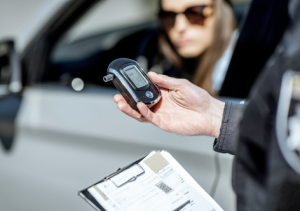Drink-driving remains a significant public health concern, with thousands of lives lost each year due to alcohol-impaired driving incidents.
The repercussions of these incidents extend beyond the immediate loss of life, affecting families, communities, and society at large through the emotional, social, and economic costs associated with such tragedies.

In response to this ongoing issue, there has been a concerted effort to leverage technology to combat the menace of drink-driving.
Advances in in-car safety technologies have shown promise in enhancing road safety by monitoring driver behavior and vehicle performance to prevent potential accidents.
Recognizing the urgency of addressing drink-driving more effectively, the National Highway Traffic Safety Administration (NHTSA) has been at the forefront of exploring and advocating for innovative solutions.
This includes the issuance of an advanced notice of proposed rulemaking, signaling a significant step towards mandating the integration of technologies capable of detecting alcohol impairment among drivers.
This move is further bolstered by the bipartisan infrastructure law, which tasks the NHTSA with developing federal motor vehicle safety standards to curb drink-driving through passive monitoring systems, marking a pivotal moment in the fight against drink-driving.
The Evolution of In-Car Safety Technologies
The journey towards today’s sophisticated in-car safety technologies began decades ago, with each advancement aimed at reducing the risk of accidents and enhancing the safety of road users.
Initially focused on passive safety features like seat belts and airbags, the focus gradually shifted toward active safety systems designed to prevent accidents before they occur.
Major car manufacturers, including Ford and General Motors (GM), have been at the forefront of this shift, integrating advanced driver-assistance systems (ADAS) such as adaptive cruise control, lane-keeping assist, and automatic emergency braking into their vehicles.
These technologies rely on sensors and cameras to monitor the vehicle’s surroundings and the driver’s actions, intervening when necessary to prevent potential collisions.
Despite these significant advancements, the current generation of in-car safety technologies faces limitations in addressing the specific challenge of drink-driving.
While ADAS can mitigate the risk of accidents by compensating for some aspects of impaired driving behavior, they are not designed to detect alcohol impairment directly.
As a result, a driver under the influence of alcohol can still pose a significant risk, as the underlying cause of impairment is not addressed by these systems.
This gap highlights the need for the development and integration of technologies specifically aimed at detecting and preventing drink-driving incidents, a challenge that the automotive industry and regulatory bodies like the NHTSA are actively working to overcome.
NHTSA’s Role and Recent Initiatives
The National Highway Traffic Safety Administration (NHTSA) plays a pivotal role in enhancing road safety and reducing incidents of drink-driving through regulatory measures and the promotion of technological innovation.
In a significant move, NHTSA issued an advanced notice of proposed rulemaking, a critical step in the regulatory process that signals the agency’s intent to explore and potentially mandate the integration of drink-driving prevention technologies in vehicles.
This initiative is part of a broader effort to address the persistent challenge of alcohol-impaired driving, which continues to claim thousands of lives each year in the United States.
In its comprehensive evaluation, NHTSA reviewed 331 driver monitoring systems to assess their capabilities in identifying alcohol impairment among drivers.
The findings revealed that, while numerous systems are currently available that monitor various aspects of driver behavior and vehicle dynamics, none of the commercially available systems are equipped to specifically detect alcohol impairment.
The agency noted that three systems claim to have the potential to identify alcohol-based impairment, but these are still in the research and development phase, highlighting a significant gap in the market for effective drink-driving prevention technologies.
The bipartisan infrastructure law further underscores the urgency of this mission, mandating NHTSA to develop federal motor vehicle safety standards that could passively monitor drivers for signs of alcohol impairment.
This legislation aims to ensure that future vehicles are equipped with systems that can detect high blood alcohol concentrations without requiring active participation from the driver, a requirement that seeks to seamlessly integrate safety measures into the driving experience.
Exploring Drink-Driving Prevention Technologies
In response to the legislative mandate and the clear need for effective solutions, NHTSA is exploring a range of technologies designed to prevent drink-driving.
Among these, driver monitoring systems and blood alcohol detection technologies stand out as promising approaches.
Driver monitoring systems focus on observing the driver’s behavior and physical signs for indicators of impairment, while blood alcohol detection technologies aim to measure the driver’s blood alcohol concentration directly, either through breath or touch.
A notable initiative in this area is the Driver Alcohol Detection System for Safety (DADSS) program, a collaborative effort between NHTSA and the Automotive Coalition for Traffic Safety (ACTS).
The DADSS program has been instrumental in developing innovative technologies, including breath-based and touch-based methods for detecting driver impairment.
The breath-based approach, while effective, is considered active and thus does not meet the infrastructure law’s criteria for passive detection.
Conversely, the touch-based method, which could be integrated into vehicle controls such as the start button or steering wheel, offers a more passive solution by automatically assessing alcohol levels when the driver interacts with these controls.
Despite the potential of these technologies, there are significant challenges to their implementation, including ensuring accuracy, reliability, and consumer acceptance.
The touch-based method, in particular, must overcome technical hurdles to accurately detect alcohol levels without false positives or negatives.
Integrating such technologies into vehicles raises questions about privacy, the potential for circumvention, and how to address situations where a non-impaired driver is not the one touching the sensor.
Addressing these challenges will be crucial for the successful adoption of passive drink-driving prevention technologies, making the road to implementation a complex but necessary journey toward enhancing road safety.
The Role of DUI Lawyers in the New Technological Landscape
As advancements in drink-driving prevention technology evolve, the landscape of DUI law and defense strategies is set to undergo significant changes.
Experienced DUI lawyers will find themselves navigating a new terrain where legal expertise in technology-related cases becomes crucial.
The introduction of passive detection systems in vehicles will likely lead to new legal challenges, including questions about the accuracy of the technology, the admissibility of evidence collected by such systems, and potential privacy concerns.
Experienced DUI lawyers will play a pivotal role in providing guidance and defense for individuals affected by these new technologies.
They will need to stay abreast of technological developments and their legal implications, ensuring that the rights of the accused are protected.
As these systems become more prevalent, lawyers specializing in DUI cases will need to develop strategies to challenge or support the evidence derived from in-car technologies, making their role even more critical in the judicial process.
Public Perception and Legal Considerations
Public opinion on the implementation of passive drink-driving prevention technologies is mixed, with many welcoming the potential for enhanced road safety, while others express concerns over privacy and the reliability of the technology.
Legal and ethical considerations play a significant role in the debate, as the introduction of such technologies raises questions about the potential for false positives, the security of personal data, and the possibility of technology being used beyond its intended purpose.
The balance between ensuring public safety and protecting individual rights is delicate, requiring careful consideration by lawmakers, manufacturers, and the public.
As these technologies advance, ongoing dialogue and transparency will be essential in addressing concerns and fostering acceptance.
Closing Thoughts
The future of drink-driving technologies promises a significant impact on reducing incidents and enhancing road safety.
As we move towards a world where vehicles are equipped with systems designed to prevent impaired driving, the balance between technological advancement, legal implications, and public acceptance will be key.
The journey ahead involves navigating complex ethical, legal, and technological landscapes, but the potential benefits for society make it a worthwhile endeavor.
The collaboration between technologists, legal professionals, and policymakers will be crucial in shaping a future where road safety is significantly improved without compromising individual freedoms.


Leave a Reply